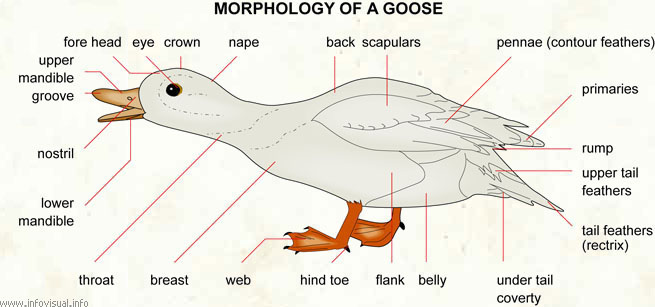Goose

Fore head: upper part of a goose's face.
Eye: sight organ.
Crown: upper part of a goose's head.
Nape: rear part of a goose's neck.
Back: rear part of the thorax.
Scapulars: shoulder feathers.
Pennae (contour feathers): long wing feathers of a bird.
Primaries: the largest feathers of the edge of a goose's wing.
Rump: projecting part of the lower back.
Upper tail feathers: feathers above the tail of a bird.
Tail feathers (rectrix): tail feathers.
Under tail covert: feathers under the tail of a bird.
Belly: front part of the abdomen.
Flank: side part of the body.
Hind toe: jointed rear appendage.
Web: thin skin joining the toes.
Breast: front part of the thorax.
Throat: front part of the neck.
Lower mandible: lower part of the beak.
Nostril: entrance to the respiratory system.
Groove: indentation on the tip of a goose's beak.
Upper mandible: upper part of a goose's beak.
Photo :
EN : Goose
plural = geese, male = gander
FR : Oie
ES : Ganso

Geese are medium to large birds, always associated to a greater or lesser extent with water. Most species in Europe, Asia and North America are strongly migratory as wild birds, breeding in the far north and wintering much further south.